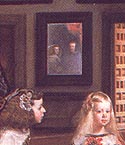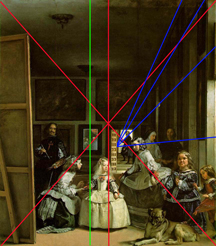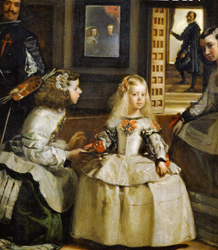Art Web | Arth
Home | Arth Courses | Arth 110
|ARTH 110 Assignments
| Forward | Back | Contact
ARTH 110
FLEMISH AND SPANISH BAROQUE PAINTING: RUBENS AND VELAZQUEZ
SLIDE LIST 14

|

|
| Peter Paul Rubens (1577-1640) Rape of the
Daughters of Leucippus, c. 1616-17. |
Bernini, Pluto and Persephone, 1621-22. |
| |

|
| |
Titian, Rape of Europa, 1538. |

|

|
| Rubens, The Toilet of Venus, 1612-15. |
Titian, Venus with a Mirror, 1555.
|
| |

|
| |
Rubens, Judgement of Paris, 1638. |

|

|
| Rubens, Raising of the Cross, 1610. |
Laocoon and his Sons, Greek, 1st c. B.C. |
|
| Rubens, drawing of the Laocoon, c. 1600-1608. |
|

|
| |
Rubens, Descent from the Cross, 1612. |

|

|
| Rubens, Portrait of Suzanne Fourment, c.
1620-25. |
Rubens, Landscape with the Chateau de Steen,
1635. |

|

|
| Velazquez (1599-1660), Adoration of the
Magi, c. 1619. |
Caravaggio, Entombment, c. 1604. |

|

|
| Velazquez, Las Meninas (Ladies in Waiting), 1656. See webpage discussion |
Detail of Las Meninas. |
|
|
| Velazquez, Philip IV in Brown and Silver, 1631-32. |
|
Question for Review
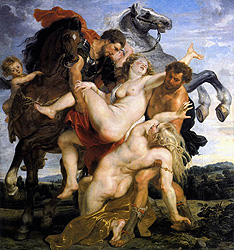
|
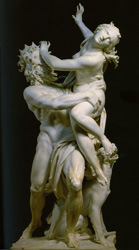
|
| Rubens, Rape of the Daughters of Leucippus,
c. 1616-17. |
Bernini, Pluto and Persephone, 1621-22. |
These are two examples of a large number of other works of the sixteenth and
seventeenth centuries that focus on the representation of rape. As works of
culture, these works can be connected to the following quotation from the contemporary
feminist art historian, Griselda Pollock: "Culture is the social level
in which those images of the world and definitions of reality are produced which
can be ideologically mobilized to legitimate the existing order of relations
of domination and subordination between both classes and sexes." Use this
quotation as a critical perspective from which to discuss early modern representations
of rape exemplified by this comparison, and contrast this to contemporary representations
of rape informed by feminism. For the latter part of this discussion, you might
want to consider the high visibility given to legal cases like William Kennedy
Smith rape trial, the Bobbitts' trials, the controversy over Anita Hill and
Clarence Thomas, and of course O.J.
Weblinks
16th and 17th century images of rape have been the focus of several
recent critical studies. Excerpts from an article by Margaret D. Carroll entitled
"The Erotics of Absolutism:
Rubens and the Mystification of Sexual Violence" and excerpts from
the opening chapter from the book by Diane Wolfthal entitled Images
of Rape: the "Heroic" Tradition and its Alternatives explore
this imagery.
Texts
Griselda Pollock, "Vision, Voice and Power: Feminist Art
History and Marxism," in Vision and Difference, p. 20: Culture
can be defined as those social practices whose prime signification,
i.e. the production of sense or making orders of 'sense' for the
world we live in. Culture is the social level in which those images
of the world and definitions of reality are produced which can
be ideologically mobilized to legitimate the existing order of
relations of domination and subordination between both classes
and sexes. Art history takes an aspect of cultural production,
art, as its object of study; but the discipline itself is also
a crucial component of the cultural hegemony by the dominant class
and gender. Therefore it is important to contest the definitions
of our society's ideal reality which are produced in art-historical
interpretations of culture.
Frederick Hartt, Art, 1976, p. 723:[Rubens's] Rape of the
Daughters of Leucippus, of about 1616-17, recalls forcibly
Titian's Rape of Europa, which Rubens carefully copied
while in Spain. Although the figures have been made to fit into
Rubens's mounting spiral, such is the buoyancy of the composition
that the result does not seem artificial. The act of love by which
Castor and Pollux, sons of Jupiter, uplift the mortal maidens
from the ground draws the spectator upward in a mood of rapture
not unrelated to that Bernini was soon to achieve in the Ecstasy
of St. Theresa. The female types, even more abundant than those
of Titian, are traversed by a steady stream of energy, and the
material weight of all the figures is lightened by innumerable
fluctuations of color running through their pearly skin, the tanned
flesh of the men, the armor, the horses, even the floods of golden
hair. The low horizon increases the effect of a heavenly ascension,
natural enough, since this painting ... constitutes a triumph
of divine love; the very landscape heaves and flows in response
to the excitement of the event.
Margaret D. Carroll, "The Erotics of Absolutism: Rubens and the Mystification
of Sexual Violence," in The Expanding Discourse: Feminism and Art History,
eds. Norma Broude and Mary D. Garrard, p. 139: Rubens's Rape of the Daughters
of Leucippus confronts its viewers with an interpretative dilemna. Painted about
1615 to 1618, the life-size composition illustrates the story recounted by Theocritus
and Ovid of how the twin brothers Castor and Pollux (called the Dioscuri) forcibly
abducted and later married the daughters of King Leucippus. Rubens's depiction
of the abduction is marked by some striking ambiguities: an equivocation between
violence and solicitude in the demeanor of the brothers, and an equivocation
between resistance and gratification in the response of the sisters. The spirited
ebullience and sensual appeal of the group work to override our darker reflections
about the coercive nature of the abduction. For these reasons many viewers have
wanted to discount the predatory violence of the brothers' act and to interpret
the painting in a benign spirit, perhaps as a Neoplatonic allegory of the progress
of the soul toward heaven, or as an allegory of marriage. Although I agree that
a reference to marriage may be at play here, I also believe that any interpretation
of the painting is inadequate that does not attempt to come to terms with it
as a celebratory depiction of sexual violence and the forcible subjugation of
women by men....
...[O]ne art historian...[concludes] that Rubens is celebrating the triumph
of natural impulse over conventional inhibition: "The battle of the sexes
is a necessity of nature. With Rubens it is a primal impulse of life, a fight
for unification.....In being raped Pheobe discovers her destiny as a woman.
Her rape reveals and enhances her nature." In claiming something like a
truth value for Rubens's celebratory depiction of this rape, this scholar mystifies
it in terms of a misguided notion of what is natural in human sexuality. My
point is that we must consider Rubens's painting not as a revelation of primal
human nature but as a phenomenon of sixteenth- and seventeenth- century European
culture. In particular we may view Rubens's painting as issuing from a tradition
that emerged among princely patrons at the time, of incorporating large-scale
mythological rape scenes into their palace decorations. With fundamental shifts
in political thinking and experience in early sixteenth-century Europe, princes
came to appreciate the particular luster rape scenes could give to their own
claims to absolute sovereignty....
Details of Las
Meninas
|
|
|
|
|
|
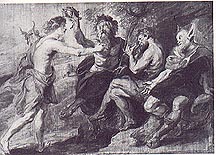
Rubens, Apollo
and Marsyas.
|
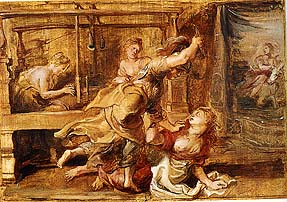
Rubens, Minerva
and Arachne.
|
Art Web | Arth
Home | Arth Courses | Arth 110
|ARTH 110 Assignments
| Forward | Back | Contact











